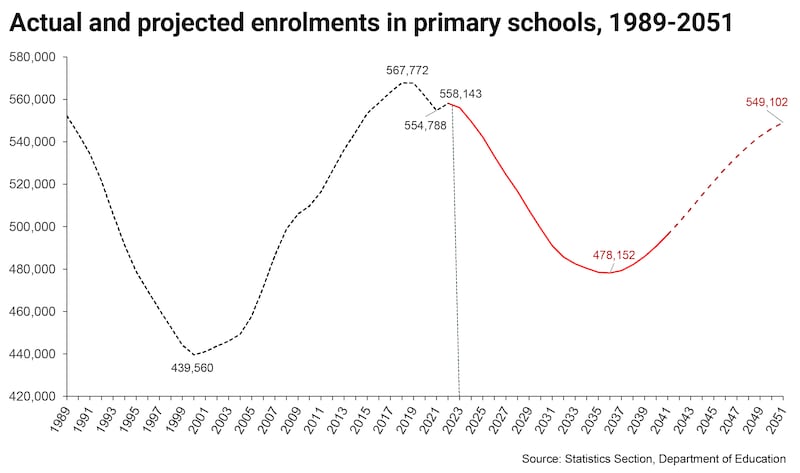The number of children attending primary school is projected to drop by 100,000, or almost a fifth, over the next decade, latest official projections show.
The falling demographics raise the prospect of an oversupply of teachers at primary level in the coming years which, in turn, could allow for smaller class sizes and lower pupil-teacher ratios.
Despite progress in reducing pupil-teacher ratios in recent years, the average in Irish primary schools is 23:1 compared with the EU average of about 20 pupils per class. About one in seven pupils are learning in so-called “supersized classrooms” of more than 30 pupils
The Irish National Teachers’ Organisation (INTO) says smaller classes allow for more individual attention and would help meet the Government’s ambition of establishing the best education system in Europe.
READ MORE
Government sources say Minister for Education Norma Foley is keen to reduce pupil-teacher ratios further, subject to resources. However, sources said such a move may have the unintended consequence of making current teacher supply issues even more challenging.
“She has always pushed for reducing pupil-teacher ratios and secured reductions for three years in a row, and would like to again, but it could conceivably create problems in filling posts at a time when we are opening hundreds of special classes, with just six pupils for each teacher,” one Government source said.
Projected enrolments for primary and second level are set out in a Department of Education report covering the 2023-2042 period. The report says peaks are due to be reached in the number of primary school enrolments this year and post-primary enrolments in 2026.
A year-on-year increase in enrolment numbers is currently being experienced by primary schools as a result of increased inward migration, including the addition of thousands of pupils from Ukraine.
The number of pupils in primary school is likely to decline from about 558,000 this year to about 533,000 in 2026 and to about 499,000 in 2030.
The projected number of post-primary pupils is expected to increase from about 417,000 this year to about 430,000 in 2026. The figure is then projected to decline to 418,000 pupils in 2030.
[ Analysis: What do falling pupil numbers mean for schools, teachers and parents?Opens in new window ]
While the drop in pupil numbers may increase the supply of school places nationally, there are still likely to be areas of enrolment pressure in some towns and cities.
The report notes that there is significant regional and local variation in enrolment projections, with residential construction one of the most significant influencing factors.
This means that, even as enrolments nationally begin to decline, there will be increasing demand for school places at primary and post-primary level in some areas. At second level, there is particular pressure securing school places in some parts of Dublin, Kildare, Wicklow and Cork.
Fine Gael Senator Emer Currie has proposed that a common applications system be set up for schools to bring greater transparency and efficiency to applications for school places. Limerick and Ennis have such a system.

In response, Ms Foley said there would be challenges in scaling a common applications system at a national level, including the complexity of factoring in each school’s unique admissions policy.
However, she said her department will review how such a system could assist with the strengthening of admissions approaches in other areas for future years.
- Sign up for push alerts and have the best news, analysis and comment delivered directly to your phone
- Find The Irish Times on WhatsApp and stay up to date
- Listen to our Inside Politics podcast for the best political chat and analysis















